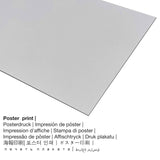Spinello Aretino, 1395 - Saint Mary Magdalen Holding a Crucifix; (reverse) The Flagellation - fine art print
Tax included. Shipping calculated at checkout.
What type of product do we offer?
In the year 1395 the artist Spinello Aretino created this piece of art named Saint Mary Magdalen Holding a Crucifix; (reverse) The Flagellation. The 620 year old version of the work of art had the following size 69 1/2 x 47 1/4 in (176,5 x 120 cm). Tempera on canvas, gold ground was used by the painter as the medium of the piece of art. Today, this artwork forms part of the digital art collection of The Metropolitan Museum of Art. This public domain masterpiece is being provided with courtesy of The Metropolitan Museum of Art, New York, Gift of the family of Francis M. Bacon, 1914. Creditline of the artwork: Gift of the family of Francis M. Bacon, 1914. In addition to this, the alignment is in portrait format and has a side ratio of 1 : 1.4, which implies that the length is 29% shorter than the width. The painter Spinello Aretino was an artist, whose style was mainly Medieval Art. The Mediaval artist lived for 65 years and was born in the year 1345 in Arezzo and passed away in 1410 in Arezzo.
Order the product material you would like to have
In the dropdown menu next to the article you can pick your individual size and material. Choose your preferred size and material between the subsequent choices:
- Printed poster (canvas material): A poster print is a UV printed flat canvas with a granular texture on the surface. Please keep in mind, that depending on the size of the poster print we add a white margin of something between 2-6cm round about the work of art to facilitate the framing with your custom frame.
- Aluminium dibond (metal print): This is a metal print made on aluminium dibond with an outstanding effect of depth - for a modern look and a non-reflective surface. The Aluminium Dibond Print is your perfect start to art replicas produced on aluminum. The bright & white sections of the original artwork shine with a silk gloss but without the glare. Colors are luminous and bright, the fine details appear crisp.
- The canvas print: A printed canvas, not to be confused with a painting on a canvas, is a digital copy printed from a UV direct printer. It generates the extra effect of three dimensionality. Also, a canvas makes a attractive and pleasant appearance. Canvas prints are relatively low in weight, meaning that it is easy to hang up the Canvas print without the use of any wall-mounts. A canvas print is suited for all kinds of walls.
- Acrylic glass print (with real glass coating): A glossy print on acrylic glass, often referenced as a plexiglass print, will turn your favorite artwork into home decoration and is a viable alternative to aluminium and canvas art prints. The artwork is made with state-of-the-art UV printing technology. The special effect of this are deep, intense color tones. The acrylic glass protects your custom art print against light and external influences for between 4 and six decades.
Important legal note: We try whatever we can in order to describe the art products as closely as possible and to illustrate them visually. Although, the tone of the printed materials, as well as the print result can vary marginally from the image on the monitor. Depending on the settings of your screen and the quality of the surface, color pigments may not be printed as realistically as the digital version. Since our fine art prints are printed and processed by hand, there might also be minor variations in the exact position and the size of the motif.
The product specs
| Article type: | art copy |
| Method of reproduction: | digital reproduction |
| Production technique: | UV direct printing (digital print) |
| Manufacturing: | German production |
| Type of stock: | on demand production |
| Proposed product use: | home décor, home design |
| Alignment: | portrait format |
| Aspect ratio: | 1 : 1.4 (length : width) |
| Interpretation: | the length is 29% shorter than the width |
| Available product materials: | canvas print, acrylic glass print (with real glass coating), poster print (canvas paper), metal print (aluminium dibond) |
| Canvas on stretcher frame (canvas print) size variants: | 50x70cm - 20x28", 100x140cm - 39x55" |
| Acrylic glass print (with real glass coating): | 50x70cm - 20x28", 100x140cm - 39x55" |
| Poster print (canvas paper) variants: | 50x70cm - 20x28" |
| Aluminium print (aluminium dibond material) size options: | 50x70cm - 20x28", 100x140cm - 39x55" |
| Art print framing: | unframed reproduction |
Background data on the original artpiece
| Painting name: | "Saint Mary Magdalen Holding a Crucifix; (reverse) The Flagellation" |
| Categorization of the artpiece: | painting |
| General category: | classic art |
| Time: | 14th century |
| Created in: | 1395 |
| Age of artwork: | over 620 years old |
| Artwork original medium: | tempera on canvas, gold ground |
| Size of the original artwork: | 69 1/2 x 47 1/4 in (176,5 x 120 cm) |
| Exhibited in: | The Metropolitan Museum of Art |
| Museum location: | New York City, New York, United States of America |
| Website: | The Metropolitan Museum of Art |
| Artwork license type: | public domain |
| Courtesy of: | The Metropolitan Museum of Art, New York, Gift of the family of Francis M. Bacon, 1914 |
| Artwork creditline: | Gift of the family of Francis M. Bacon, 1914 |
About the artist
| Name of the artist: | Spinello Aretino |
| Artist nationality: | Italian |
| Jobs: | painter |
| Country of the artist: | Italy |
| Classification: | old master |
| Styles of the artist: | Medieval Art |
| Died at the age of: | 65 years |
| Birth year: | 1345 |
| Hometown: | Arezzo |
| Year died: | 1410 |
| Town of death: | Arezzo |
© Copyright of | Artprinta.com
Artwork information by The Metropolitan Museum of Art website (© Copyright - by The Metropolitan Museum of Art - www.metmuseum.org)
Painted on both sides, this extremely rare work was commissioned about 1395–1400 by the Confraternity of Saint Mary Magdalen in Borgo San Sepolcro and would have been carried in religious processions. On one side the hooded members of the confraternity kneel before their patron saint. On the reverse is the Flagellation of Christ—a reminder of the penitential practices members would have performed. Laymen often joined religious confraternities for communal devotions and charitable acts. Their hooded robes rendered such acts anonymous, in conformity with Christ's injunction that good works should not be done for vain praise.The face of Christ is a photographic facsimile of the original painted face, which was detached in the nineteenth century and is now in the Camposanto Teutonico, Rome.














